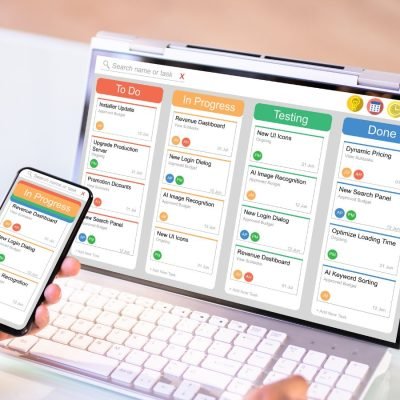Business process management, or BPM, is about making business processes work better with the big goals of a company. It covers everything from designing processes to checking how well they work. The idea is to boost how much work gets done, do it better, and be able to change fast when needed. At the heart of BPM is using technology to automate tasks. This saves money, makes things run better, and speeds up how quickly you can do things. Plus, by always looking for ways to improve, BPM helps a company shine in what they do.
Key Takeaways:
- Business process management (BPM) aligns business processes with organizational goals.
- BPM involves process design, modeling, execution, monitoring, and optimization.
- Automation is a key component of BPM, driving efficiency and cost savings.
- Implementing BPM as a cultural focus promotes continuous improvement.
- BPM is essential for driving operational excellence in organizations.
Understanding Business Process Automation
Modernizing business operations is all about process automation. It uses tech to handle manual and repetitive tasks. This frees up time and resources for better use. Business process automation (BPA) targets these tasks within a company.
It brings many benefits, like making things more efficient, reducing mistakes, and standardizing how things run.
BPA is important for making work processes smoother and boosting productivity. It makes daily tasks automatic, letting workers focus on growing the business. Remember, BPA is different from business process management (BPM). BPM looks at big, complex processes throughout an organization. In contrast, BPA zeros in on automating specific tasks and duties.
Robotic process automation (RPA) is a type of BPA. It uses software robots to do tasks as if they were human. RPA is great for automating tasks that follow rules and are the same every time, but are spread across different programs. This boosts accuracy and speed.
Rolling out BPA needs a good plan and a deep look at what a company already does. It’s key to find the tasks that, when automated, will make the biggest difference. Tasks might include entering data, making reports, handling invoices, and setting up new customers.
With BPA, companies can work more efficiently, cut costs, and be ready for growth in the future.
“Automation is not merely a supplement to human labor, but a means of augmenting human capacity.”
– Elon Musk
Benefits of Business Process Automation
Business process automation has many perks for all types of organizations. Here are the top gains:
- Enhanced Efficiency: It reduces errors and speeds up tasks, making everything go faster and better.
- Standardized Operations: BPA makes sure processes are always done the same way, cutting down on differences and upping quality.
- Cost Savings: By taking over manual work, companies can save money and use their resources better.
- Improved Compliance: It helps in keeping up with rules, making sure a company meets all legal and industry standards.
- Increased Customer Satisfaction: Operations being smoother means faster service, fewer mistakes, and happier customers.
Business process automation is like an entryway to becoming more digital. It helps companies work better, meet changing market needs, and keep up with the fast business world.
Business Process Automation Examples
Business process automation (BPA) is all about making work better. It helps organizations do things faster, with less mistakes. This leads to more work getting done. Let’s look at how BPA can change different parts of a business.
1. Employee Onboarding
Automating how new employees get started can make things smoother. BPA helps create digital paperwork fast. It also sets up the new employees on the company’s systems easily. They can even do some things themselves.
2. Purchase Orders
Using BPA for purchase orders makes things clearer and more reliable. It automates making orders, getting them approved, and keeping track. This cuts down on mistakes and the need for people to step in. The result: buying things goes smoothly.
3. Customer Service
Automating how companies talk to customers can speed things up and make customers happier. BPA can direct questions to the right people fast. It keeps a helpful database up to date and starts talking right away with chatbots. This means faster answers and better service.
4. HR Processes
BPA is also great for HR tasks like managing time off or doing performance reviews. It automates a lot, which means less paperwork. HR can now help employees better because they’re not stuck in endless admin jobs.
5. Marketing and Sales
In marketing and sales, BPA can make getting new customers and managing sales easier. It deals with boring jobs like emailing many people and tracking what happens. This lets salespeople and marketing folks focus on the fun, creative parts of their jobs.
6. Accounting and Finance
For money matters, BPA is a game-changer. It takes over things like handling bills and making financial reports. This means less chance of errors and more time for the finance team to support business growth.
7. Data Entry
Data entry doesn’t have to be done by hand anymore thanks to BPA. It uses smart tools to understand written words and number. This makes data more reliable and easier to work with.
8. Management
BPA helps bosses too, by offering to handle projects and giving them the info they need quickly. This means more time for big decisions that steer the company to success.
Adding BPA to different areas of a business can make it work better. It boosts how much is done, lowers mistakes, and makes everyone’s job smoother.
Benefits of Business Process Automation
Today, companies find that automating their processes is key to running smoothly. This move is critical in the current digital age. Automation is the first step towards a full digital makeover. It brings a host of advantages that can push companies ahead.
Improved Clarity and Process Efficiency
By automating, companies clear up how they work. They cut out manual jobs and ditch paper tasks. This makes everything flow better. Workers can then focus on the jobs that really matter. This creates value for the company.
Automation also slashes the chance of mistakes. With processes set by BPA, jobs are performed right every time. This boosts efficiency. It also makes the work’s quality and dependability top-notch.
Compliance and Audit Trail
Keeping up with rules can be hard with manual methods. Mistakes often happen, making it tough to track changes or prove you follow rules. BPA makes managing compliance simpler. It keeps a clear log of every step.
With BPA, getting hold of compliance records is easy. You can follow changes and see every process step. This makes it easier to pass checks. It also boosts the transparency during audits.
Standardized Operations and Increased Customer Satisfaction
BPA helps companies keep their operations in line, no matter the team or dept. This consistency cuts out mistakes. It means customers get a more uniform service or product. That makes them happier.
Cutting out manual hurdles means companies can deal with customers quicker. This raises customer satisfaction. Fast and efficient services show you care. It makes your business seem more reliable and customer-focused.
So, BPA not only helps inside a company. It also improves how others see you. By bettering efficiency and operations, it shows you’re serious about what you do. This improves your standing in your field.

| Manual Processes | Automated Processes |
|---|---|
| Prone to errors and inconsistencies | Reduce errors and ensure consistency |
| Susceptible to delays and bottlenecks | Fast and efficient processing |
| Lack of visibility and accountability | Clear audit trail and accountability |
| Time-consuming and resource-intensive | Time-saving and resource-efficient |
| Inflexible to accommodate changes | Flexible and adaptable to changes |
As seen in the table, automating has numerous pluses. Lower errors, faster processing, and more visibility, BPA is a clear winner.
Using BPA boosts efficiency and compliance and keeps everything standard. This makes customers happier. So, BPA is essential for companies wanting to succeed today.
What Business Processes to Automate
When discussing business process automation, not all tasks fit the bill. Some jobs are perfect for automation, while others need a human touch. By automating certain processes, companies can make things easier, cut down on mistakes, and do more work. Here are some tasks often handled by machines:
Email and Push Notifications
Automated emails and updates save a lot of time and energy, particularly with talking to customers, running promotions, and keeping people updated.
Helpdesk Support
Automating helpdesk support means handling tickets more easily, putting the urgent ones first, and replying to customer questions fast.
Finance and Accounting
Handling money and keeping accounts in order through automation helps lower mistakes. It ensures finance details are right on time.
Procurement
Automation in buying makes it easier to request, okay, and manage goods. It saves money and makes managing the supply chain better.
Call Center Processes
Automating how calls are directed and storing customer info can make things faster. This can make customers happier and help customer service agents work better.
Sales Orders
Automating sales from the order to the delivery boosts the speed, cuts errors, and makes orders more correct.
Time and Attendance Tracking
Getting rid of time cards and tracking days worked automatically raises accuracy. It also makes paying employees easier.
Payroll
Handling pay through automation makes it easier to calculate, take out taxes, and pay straight to the bank. This keeps paychecks correct and on time.
Invoicing
Creating invoices, checking when they’re paid, and reminding when they’re not speeds up how bills are sent out. It also can help money move better.
Collections
Automation in collecting debts means following up is easier, seeing payment history is clearer, and sending reminders happens automatically.
Product Launches
Automating the launch of a product by assigning tasks, tracking progress, and keeping phone lines open is key for a good start.
Lead Nurturing
Setting up automatic ways to keep in touch with potential customers, like through emails and scoring systems, can boost sales.
These are just a few examples of business processes that can be automated. Tasks that are done a lot, need to happen quickly, and have strict rules are great for automation. Knowing which processes to automate can make a big difference in how well a business runs.
Commonly Automated Business Processes
| Process | Benefits |
|---|---|
| Email and Push Notifications | Streamlined communication, improved customer engagement |
| Helpdesk Support | Faster response times, improved customer satisfaction |
| Finance and Accounting | Reduced errors, accurate financial records |
| Procurement | Cost savings, enhanced supply chain management |
| Call Center Processes | Improved agent productivity, better customer service |
| Sales Orders | Efficient order processing, increased order accuracy |
| Time and Attendance Tracking | Eliminated manual processes, simplified payroll |
| Payroll | Accurate and timely employee payments |
| Invoicing | Accelerated billing cycle, improved cash flow |
| Collections | Streamlined debt collection, improved financial management |
| Product Launches | Coordinated launch, improved project management |
| Lead Nurturing | Increased conversion rates, enhanced customer relationships |
Conclusion
Business process automation and cloud technology offer many benefits. They help companies save money, grow, and stay secure. BPA changes how businesses work, especially in customer service and finance.
Yet, challenges exist when using BPA. Companies must manage changes well and train employees. Overcoming these hurdles helps make the switch to automation easier and more beneficial.
The future of BPA looks bright. AI and ML will make automation smarter. To lead in technology, companies need to adopt these tools quickly.






